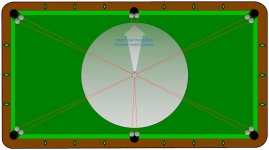Duckie brought up a good point about the margin of error being different depending on the shot angle. But we were talking about two different margins of error. I was only thinking of the margin of error at the pocket, which is the maximum tolerance in degrees the ob could be off from center pocket and still drop into the hole. This is typically what most people refer to when talking about margin of error. The cb location does not change this, as the margin of error is only derived from pocket width, ob distance from pocket, and ob approach angle to the pocket.
However, any margin of error measured at the ghostball or aimpoint end of the shot line, or even right at the cb itself, is related directly to aiming, and this is where the relationship between cb and ob comes into the mix.
At larger cut angles, primarily greater than 30°, the allowable margin for aiming error decreases quite a bit. Example: Using ghostball aiming on a straight in shot where the ob has a margin or error of +/- 2° at the pocket.... This allows you only 0.078" (a little more than 1/16 of an inch) left or right of the perfect ghostball location. If your idea of where the cb needs to be (ghostball location) is off by anymore than this then you're likely to miss the shot.
For a 30° shot angle on this same ob the allowable aiming error would be about 87% of what it is for the straight in shot. This means you'd have +/- 0.068" (closer to 1/16 of an inch). With a 48° degree shot on the ob the allowable room for aiming error would be about 66% of what it was for straight in, which would make it +/- 0.052 (less than 1/16 of an inch). And for a 60° shot angle the room for aiming error would only be +/- 0.039" (about 1/32 of an inch).
However, any margin of error measured at the ghostball or aimpoint end of the shot line, or even right at the cb itself, is related directly to aiming, and this is where the relationship between cb and ob comes into the mix.
At larger cut angles, primarily greater than 30°, the allowable margin for aiming error decreases quite a bit. Example: Using ghostball aiming on a straight in shot where the ob has a margin or error of +/- 2° at the pocket.... This allows you only 0.078" (a little more than 1/16 of an inch) left or right of the perfect ghostball location. If your idea of where the cb needs to be (ghostball location) is off by anymore than this then you're likely to miss the shot.
For a 30° shot angle on this same ob the allowable aiming error would be about 87% of what it is for the straight in shot. This means you'd have +/- 0.068" (closer to 1/16 of an inch). With a 48° degree shot on the ob the allowable room for aiming error would be about 66% of what it was for straight in, which would make it +/- 0.052 (less than 1/16 of an inch). And for a 60° shot angle the room for aiming error would only be +/- 0.039" (about 1/32 of an inch).
